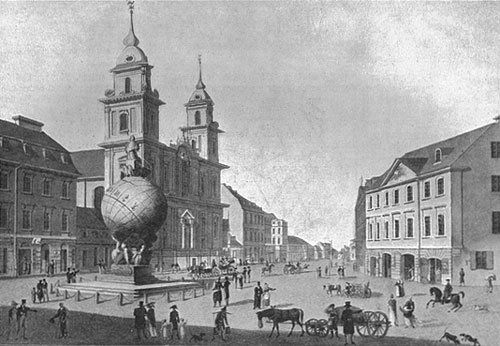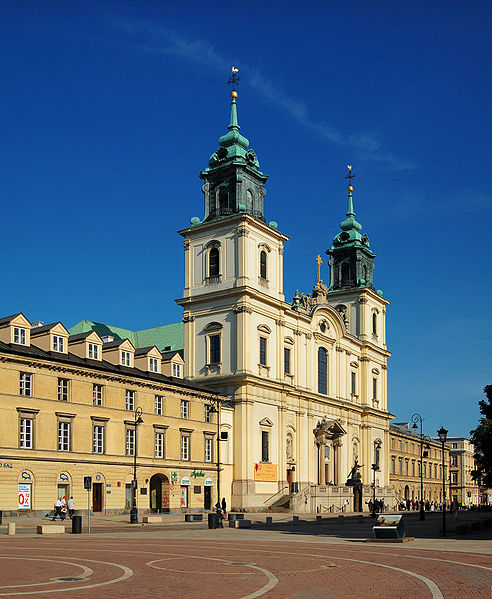Holy Cross Church in Warsaw, Poland has been noted for its prominence for over six centuries.
Over the course of time, the church structure was demolished and rebuilt several times . The first mention of the church dates from 1510 when a roadside chapel stood at the location of the present church . On 01 December 1653, the church was transferred to the Congregation of the Mission, a group of friars dedicated to Saint Vincent de Paul.
In 1679, the Congregation decided to build a new church . Construction began on 01 April 1682 when Prince Jakub Sobieski laid the cornerstone and was completed in 1792, 110 years after construction was begun, when four bells were hung in the bell tower . Just two years later, in 1794, the Kosciusko Uprising broke out, during which the church was heavily damaged.
Holy Cross Church before 1828
SOURCE: Holy Cross Church before 1828 (Warsaw, Warsaw Obwód, Mazowsze Voivodeship, Congress Kingdom of Poland);Â image in the public domain.
In 1849, the heart of composer Frédéric Chopin was interred in Holy Cross Church and, in 1929, the heart of writer and Nobel Laureate Władysław Reymont was interred there as well.
During the Siege of Warsaw in 1939, a field hospital was formed in the lower church . During this time, the church was seriously damaged by bombing and the images of the Great Altar and the Altar of the Blessed Sacrament were destroyed . On 03 October 1939, the Gestapo arrested the church’s missionaries . The missionaries were released two weeks later.
On 07 February 1944, the police plundered the church and arrested the missionaries . Most were sent to the Gross-Rosen Concentration Camp where eight of them died . The church continued to be under constant attack . On 06 September 1944, the Nazis detonated two Goliath tracked mines in the church and, in January 1945, a few days before abandoning Warsaw, the Nazis blew up the church tower in which the bells were hung . Some of the bells were destroyed and the rest were removed by the Nazis.
On 17 October 1945, the urn with Chopin’s heart, which had been removed for safekeeping, was returned to the church . Reconstruction of the church began in 1945 and the facade was completed in 1953 . The main altar was consecrated in 1969.
On 21 January 2002, Pope John Paul II elevated the status of the church to Minor Basilica.
Holy Cross Church in 2010
SOURCE: Holy Cross Church in 2010 (Warsaw, Warsaw Powiat, Mazowsze Voivodeship, Congress Kingdom of Poland); photographed by Marcin Białek on 06 June 2010; reproduced under the GNU Free Documentation License.
So, what is the significance of Holy Cross Church to me and my genealogical research?
My third great grandparents, Wojciech Gutowski and Marianna Jedlińska, were married in the Holy Cross Church on 07 October 1832 . As it turns out, genealogy blogger Donna Pointkouski’s second great grandparents, Stanisław Piątkowski and Apolonia Konopka, were married in this same church on 10 May 1863 . Since they were married in the same church, did our ancestors know each other? Holy Cross Parish was enormous, so I suspect it is unlikely our ancestors knew each other, but who knows?
Written for the 109th Edition of the Carnival of Genealogy.






Steve,
Looking at the photo of the church reminded me of a question I have yet to find answer for. Why are alot of buildings built without a space between them? Especially churches. I realize in large cities that you eventually run out of space, but as in your photo above it appears that space isn’t an issue.
Just one of those questions that has nagged at me for awhile. LOL
Unlikely? Probably… But I, for one, would really like to think they did know each other. 😉